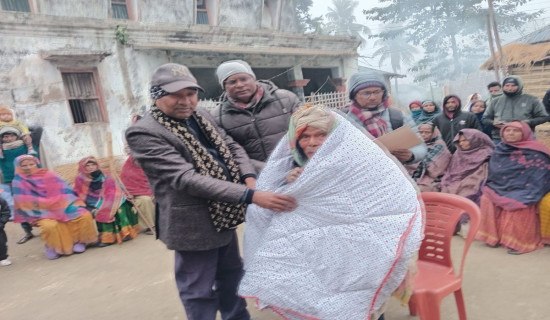- Thursday, 8 January 2026
People Still Losing Lives To Tuins
In 2015, the then government had promised to replace tuins (wire bridges) with suspension bridges across the country at the earliest to save the lives of people from such a risky means of river-crossing. With that announcement, the government had received a lot of applauds from people, especially those living in remote rural districts. In September 2020, former Prime Minister KP Sharma Oli even claimed that the hazardous mode of river-crossing by tuins was replaced by bridges. He made that observation while addressing the General Debate of the 75th Session of United Nations General Assembly (UNGA).
But what is mocking is that tuin-related deaths are still recorded in some remote districts where people have no alternative but to use the perilous wire bridges for crossing the rivers. Sandal Singh Bhandari, a resident of Byas Rural Municipality-2 of Darchula district, died on Saturday (April 22) as he fell off a wire-crossing over the Mahakali River. Media reports have it that the 45-year-old fell into the river at Dumling area. He was heading to an Indian market located in Dharchula of India from his village. As soon as the misfortune happened, the security personnel with the help from locals carried out a search and recovered his body from the river.
Disappearance
The record maintained by the rural municipality's ward office shows that as many as 64 people have fallen into the Mahakali River only in Darchula since 1959. With the river being very deep and unavailability of a trained rescue team there, only three bodies have been recovered so far. The remaining 61 people have gone missing. It is dismaying that as many as 25 residents of Byas Rural Municipality-2 have disappeared after falling from tuins while 19 from Ward No. 5.
As the residents of different parts of Darchula have to depend for daily consumer goods on the nearby Indian market, they are bound to cross the Mahakali River using tuins. In areas where there are no tuins, people are found using even car tubes to cross the river, putting their lives at higher risk. Several people have lost their lives while taking such a dangerous course.
In Darchula, there are only 10 suspension bridges in operation over the Mahakali River. These bridges link Nepal with India. Under its tuin replacement scheme, the Nepal government has built four bridges over the river. But these bridges are not adequate for the locals who live in scatted settlements across this far-flung district. This is the reason why they are found opting for hazardous tubes to get to the other bank of the river. Efforts are also underway to construct a motorable bridge over the river connecting Asigada of Mahakali Municipality-8 in Darchula and Mallacharchum of Pithauragadh in India.
It needs no mention that Nepal is home to well over 6,000 rivers, rivulets and streams. In hilly and mountainous regions, these watercourses are seen leaving numerous places without any means of crossing. Many people die while others get wounded in course of crossing the rivers. They are either forced to swim or use grass rope with a wooden pulley. Due to unavailability of concrete or suspension bridges, tuins are commonly used as an indigenous technology for crossing the rivers. But such wire bridges are unsafe and sometimes life-threatening as well. Despite some improvement in the tuin technology, they are still risky. If rivers are flowing through plain areas, people often use simple boats. These boats are also not safe as they are always at risk of being overturned. Incidences of boat capsize are reported frequently in different parts of the country.
According to a study carried out to upgrade the prevailing tuin technology, the community people showed their serious concerns over the safety of the traditional tuins. They said that there was always a risk factor related to the falling down of the trolley while crossing. In 2007-08, five improved tuins were set up in Phisling and Bhuwanitar of Gorkha, Solung of Tanahaun, Khulalu of Kalikot and Saranigad in Achham districts. Practical Action Nepal, an NGO, with the financial assistance from the European Union, had implemented this plan.
Safety issues
However, Nepal government has adopted the policy of replacing all tuins with trail bridges considering the former's safety issues. In 2018, the Ministry of Federal Affairs and General Administration instructed every local government to list all tuins which were not in priority for replacement. The Ministry also called on them to report to it if there were such means of crossing rivers within their jurisdictions. In 2015, the government had come up with a plan to replace all tuins within two years. It had allocated Rs. 3.25 billion for that as well. The ministry had also planned to survey areas where tuins had to be substituted instantly.
But the problem is that people are still disappearing after falling from tuins. It is unclear how many wire crossings have so far been replaced with suspension bridges across the country. The relevant agencies must intensify their efforts to build replacement bridges in needy areas to make sure that people do not have to risk their lives unreasonably. However, dispersed settlements in remote areas have become a challenge for the government to set up suspension bridges. It is necessary for the three-tier governments to work out plans to develop integrated settlements in feasible places in order to replace tuins and protect the people who are vulnerable to natural disasters like flash floods, landslides and earthquakes.
(The author is a deputy executive editor of this daily.)

















